Abstract
The majority of long-span bridges and offshore construction in deep water are supported by bored pile foundations. Pile foundations under water will be susceptible to scour, which will pose a significant danger to their safe operation. A three-dimensional finite element (FE) numerical analysis was conducted to examine the influence of scour on the responses of laterally loaded drilled piles in marine clays. First, the FE numerical model was calibrated using field test data of a drilled pile that did not include scour in soft marine clay. The findings of numerical modeling reveal that scour decreases the ultimate lateral capacity of socketed drilled piles, with the percentage of reduction being strongly related to scour types and depth, but moderately related to scour hole width and slope angle. Finally, a semi-empirical formula for calculating the effects of scour on the lateral capacity of socketed drilled piles following scour is presented. This method may be utilized fast and effectively to calculate scour’s effects.
1. Introduction
Recent years have seen the widespread usage of drilled shaft pile foundations in long-span bridges and deepwater offshore structures susceptible to lateral stresses such as wind, waves, and water flow. Consequently, pile foundations located in water are susceptible to scour, which will increase the soil-free support length of piles and influence the pile lateral deflections, resulting in a reduction in the soil’s effective stress and, consequently, the collapse of the bridge [1,2]. According to Lagasse et al. [3], scour is responsible for 60% of bridge failures in the United States, resulting in human and financial losses. Therefore, it is necessary to investigate the effect of scour on the behavior of laterally loaded piles.
Global scour and local scour are the two primary forms of scour that affect bridge foundations. Global scour refers to the global lowering of the riverbed and is independent of the bridge’s existence [4]. Meanwhile, the flow directly disrupted by the pile construction causes the creation of a scour hole around the foundation, that is, local scour. The scour mechanism of piles has been extensively studied, e.g., [5,6,7], which could give us a deep understanding of the scour phenomenon. Melville and Raudkivi [8] were the pioneers to measure the turbulent flow field within the scour hole close to a bridge pier using a hot-film anemometer. They discovered that the flow became more complicated as the scour developed. In addition to these discoveries, their study piqued academics’ interest in the subsequent decades regarding the flow field configuration around a bridge pier during scour. According to Xiao et al. [9], the eventual scour depth is determined by the geometry of the foundation, the incoming flow, the sand, and the fluid properties. In addition to scour depth, the time scale of scour [10], and the shape of scour holes [11] were also investigated. Furthermore, according to Wang, Yu, and Liang’s comprehensive analysis [12] of scour in the context of bridges, bridge scour comprises not only hydraulic factors but also geotechnical and structural features, which are impacted by others. For the current application, both of the above-mentioned scour types will alter the support conditions and provide a substantial challenge, particularly due to their huge influence on the lateral capacity of pile foundations.
Numerous scholars have also conducted a number of studies on the laterally loaded monopile. Several empirical and computational approaches for assessing the load-deformation behavior of piles subjected to lateral loads have been presented, which provides a basis for the study of the horizontal response of piles under scour conditions. (Matlock; Lee and Gilbert; Duncan et al.; White et al. [13,14,15,16]). Matlock and Reese [17] were the pioneers in developing design curves for predicting pile deflections in an elastic medium, and Reese [18] demonstrated that in cohesive soil, scour may significantly reduce the lateral load capacity of a pile. Recently, Fatahi et al. [19] and Kim et al. [20] reported a 3D finite element analysis to simulate a lateral load test utilizing PLAXIS with a Mohr–Coulomb plastic model for the soil. Their results indicate that numerical modeling techniques based on the FE offer versatile tools that can describe soil continuity, soil nonlinearity, soil–pile interface behavior, and 3D boundary conditions. Lin et al. [21] introduced modified p-y curves for the study of laterally loaded piles in soft clay in order to examine the influence of scour on the lateral response of a pile. By comparing the results to a 3D finite difference model (created using FLAC3D), it was determined that disregarding the dimensions of scour hole could result in 10–19% greater lateral displacement at the pile head and 6–8% greater bending moments compared to when these dimensions are explicitly considered. Using numerical modeling, Mostafa [22] studied the effect of scour types (local and global) on the lateral response of piles in cohesive and cohesionless soils. The study revealed that piles built in sand were more susceptible to erosion than those in clay. In sand, scour depths ranging from 1D to 3D increased lateral pile head displacement by 37 to 155% compared to the absence of scour. In addition, global scour induced considerable increases in bending moments, resulting in a greater impact of scour on piles subjected to enormous lateral loads due to nonlinear pile-soil interaction effects. Li et al. [4] discovered that the lateral reaction of a pile differs depending on the kind of scour, with global scour producing more significant moments than local scour. Their research showed that the size of the local scour hole has a significant effect on the lateral response of the pile. However, few studies have been conducted to investigate the effects of local scour hole dimensions and global scour depth on the behavior of the bored pile under scour, and the existing studies do not provide a straightforward and rapid method for estimating the loss of lateral capacity of the bored pile due to scour. In addition, it is difficult to determine the lateral capacity of socketed drilled piles using laboratory tests. Conducting systematic numerical tests to evaluate the scour impact on the lateral behavior of drilled piles is, therefore, of major importance.
The objectives of this numerical study were: (1) to validate the numerical model using field data of a laterally loaded pile; (2) to investigate the effects of scour types and the morphological characters of a scour hole on the behavior of a bored pile under scour and (3) to present a semi-empirical formula for predicting the lateral capacity of a bored pile after scour expressed by dimensionless parameters; its applicability was validated.
2. Materials and Methods
Under scour circumstances, the lateral reaction of a chosen bored pile (drilled shaft) has been simulated using a FE model. The 3D FE model predictions were evaluated using the lateral load test results of drilled pile LTP-4 at the Incheon Bridge site to validate the FE model. In this research, a field and numerical study on the behavior of laterally laden piles at the Incheon Bridge [20] was selected. The pile was subjected to a field loading test under the condition of a free pile head, and the characteristics of the pile are given in Table 1.

Table 1.
Pile properties for bored pile LTP-4 (Reprinted from [20] with permission from Elsevier).
The test drilled pile LTP-4 measured 2.4 m in diameter, 44.3 m in embedment length, and 14.3 m in rock embedment. The pile was subjected to lateral stresses at a height of 0.5 m above the ground surface (e = 0.5 m). Kim and Joeng [20] provide further information on pile installation.
Using PLAXIS 3D V21.01, the LTP-4 pile system was simulated (2021). According to the finite element model, the drilled pile had a diameter of 2.4 m (as per the measurements in the field testing). The distance between the outside border of the pile and the square’s edges was 15 times the diameter of the pile. In the meantime, the model’s vertical size was increased to 1.5 times the length of the pile (Figure 1b). These dimensions were deemed enough to remove the boundary effect’s impact on pile performance [23]. The original model comprises 68,732 nodes and 43,059 elements, while the scour finite element model has a similar number of nodes and elements. Figure 1 depicts the 3D mesh utilized in the finite element model (a). The water table is at the surface of the land, and Figure 1 depicts the subsurface contour (b). The modeling was conducted in non-drained circumstances. As seen in Figure 1a, the perimeter of the mesh is fixed against displacements. Meanwhile, the surface of the ground is mobile in all directions. In this numerical simulation, the pile and soil are represented using finite elements, allowing for a thorough study of the soil–structure interaction.

Figure 1.
(a) Boundary conditions and (b) subsurface profile of the FE model.
For models requiring investigation of soil–pile interaction, interface components at the soil-structure interface are required. The interface components indicate a virtual thickness and have strength qualities related to the surrounding soil layer’s strength values. A pair of nodes defines the interface element, which has the benefit of permitting sliding and separation when differential displacements occur. Mohr–Coulomb criteria are used to determine the shear strength of the interface, while the tensile strength is set to zero to allow for a gap between the pile and the supporting soil in the pile foundation. The principal interface parameter is the strength reduction factor (), which accounts for the drop in strength and stiffness of the interface element in the appropriate soil layer. Using integration points and Gaussian integration, the stiffness matrix for 3D wedge interface parts was generated. serves to model the soil-structure interface by decreasing the cohesiveness (), friction angle (), and shear modulus () at the interface using the following relationships:
where: is the interface reduction coefficient ( < 1), is the cohesion of the interface, is the cohesion of the surrounding soil, is the friction angle of the interface, is the friction angle of the surrounding soil, is the shear modulus of the interface, is the shear modulus of the surrounding soil, is the dilatation angle of the interface, and is the dilatation angle of the surrounding soil.
This study’s modeling requires the design of many calculation stages to enable the computing of initial stresses in the model and the calculation of the model’s response to diverse lateral loads. Due to the complexity of modeling pile installation, and the scour process and the installation process being in different stages of use, the pile is assumed to be in a stress-free state at the beginning of the research, and the impact of pile installation is neglected [23]. The approach was chosen as the PLAXIS calculation method for computing the initial stresses existing in the modeled soil-pile system. values can be calculated using the following formula:
where: is the coefficient of lateral earth pressure at rest for the normally consolidated stress range, is the Poisson’s ratio, is the effective vertical stress, is the over-consolidation ratio, and is the past-overburden pressure.
The parameter investigation of the and values of the Incheon Bridge pile foundation can be found in Fatahi et al. [19], which determined that will have a negligible impact on the projected values. Based on several field tests and numerical simulations concentrating on the lateral response of the pile at the Incheon bridge, e.g., [19,20,23,24], the material properties used in the modeling are summarized in Table 2.

Table 2.
Material properties adopted in the numerical model (Reprinted from [20] with permission from Elsevier).
2.1. Validation with Field Lateral Load Tests
Based on the above-described characteristics of the constitutive model, the response of the lateral load pile without scouring is verified according to the distribution of lateral deflection and bending moment. As shown in Figure 2, the measured bending moment value is greater than the calculated value in the lower clay layer, which can also be obtained in the study of Kim and Joeng [20], which may be related to the gap between the simplification of the soil layers and the piling process. However, the general trend of measured displacements and bending moments is closely predicted by FE analysis.
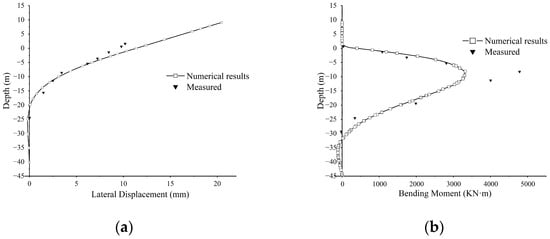
Figure 2.
Computed and measured response of bored pile (a) Depthlateral displacement (b) depthbending moment.
2.2. Mechanics of Scour
As shown in Figure 3, the downward pressure gradient causes the downflow as the flow velocity falls from the water’s surface to its bottom. The interplay between the downflow and incoming flow will create a horseshoe vortex system in front and to the side of the pier [25]. Moreover, the wake vortex system is formed downstream of the pier as a result of the separation of water flow on both sides. Under the influence of these flow field structures, local scour is formed around the pier [26].
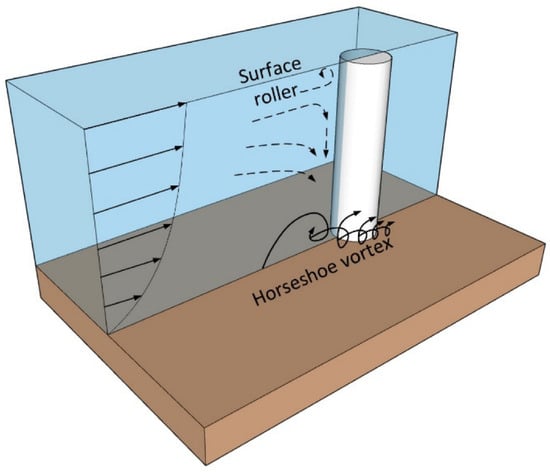
Figure 3.
Mechanics of scour [27].
Here are the basic steps for modeling the scour and lateral load tests: (1) initial stresses were generated through gravity loading, and the pile was created by altering material types; (2) some elements were removed based on the types of the scour, and then the equilibrium of the mode was reconstructed and (3) a lateral load was applied.
3. Results and Discussion
3.1. Lateral Load Capacity
According to the applicable Chinese code (Technical code for building pile foundations (JGJ94-2008)), the lateral load equivalent to a pile displacement of 10 mm at ground level was taken as the lateral load capacity of the pile. According to Broms [28], the ultimate lateral load of the pile must equal 20% of the pile’s diameter in order to achieve the pile’s ultimate capacity with a safety factor of 2.0. In fact, the permissible displacement of piles varies by application type [29]. To explore the effect of scour on the behavior of laterally loaded piles in soft clay, the maximum lateral deflection was limited to 5% of the pile diameter (120 mm) in this study, which might be regarded as high enough to generate safety issues in practice [30]. In this study, the primary influencing parameters, including scour types, width, depth, and slope of the scour hole, were investigated.
3.2. Effect of Global Scour
Figure 4 depicts global scour and local scour. Global and local scour produce different changes in effective stress [4], hence influencing the lateral reactivity of the pile. In practice, the scour depth can range from 0.5 to 15 m [2]. In this study, the global scour was modeled by removing a soil layer with a thickness ranging from 0 to 3 times the diameter of the pile, and the numerical simulation was conducted with a set of circumstances equal to 0.5 times the diameter of the pile.
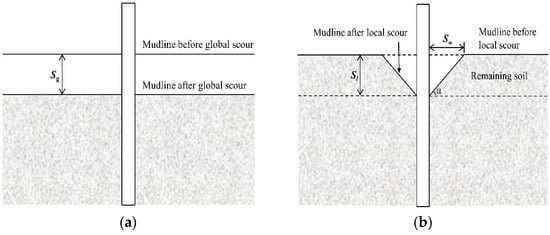
Figure 4.
Global scour (a) and local scour (b) around pile foundations.
Figure 5 illustrates the connection between pile head displacement and lateral pile load at various global scour depths. Under lighter lateral stresses, the pile-soil behavior is linear, hence the difference is insignificant. Due to the nonlinear nature of the pile-soil system, the disparity becomes significant for greater lateral loads. For instance, when the permitted lateral deflection (δ) is set to 5% of the pile diameter, the lateral load capacity is 2640, 2262, and 1512 kN for Sg/D = 0, 1, and 3, respectively. Under a scour depth of 7.2 m, the residual lateral load capacity of the piles is about 57% of that with no scour, based on the permitted lateral deflection of 5% of the pile diameter. Figure 5b provides a summary of the connection between load capacities and scour depth in Figure 5a. The ordinate is the ratio of HR to HR0, where HR represents the pile capacity after scour and HR0 is the pile capacity prior to scour. This ratio may be utilized to examine the effects of scour on the pile’s capacity [31]. The test results are shown by squares in Figure 5b. The pile capacity at Sg = 0.5D, 1D, and 2D reduces by 4.98 %, 14.32 %, and 29.31 %, respectively.
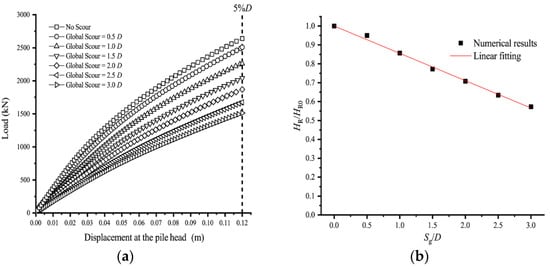
Figure 5.
Global scour effects on (a) load-displacement curves and (b) pile capacities.
This ratio may be used to analyze the scour effects on the final capacity of the pile; the lower the ratio, the stronger the scour effects. The solid red line in Figure 5b displays the linear fitting result within the range of 0~3D global scour depth, and its equation is (6). The coefficient of determination R² for the linear fit is 99.98%, which indicates a strong relationship.
3.3. Effect of Local Scour
Figure 4b provides the symbols and definitions for a scour hole, which are mentioned below: (1) scour hole width, Sw; (2) scour hole depth, Sl and (3) scour hole slope angle, α. These parameters and symbols will be used in the discussion that follows.
3.3.1. Effect of Slope Angle α
Figure 6a shows the lateral load versus lateral deflection curves of pile heads at various scour slope angles. When the load was less than 1000 kN, the influence of the scour hole slope angle on the lateral response of the pile was insignificant, and the connection between the pile lateral load capacity and the scour hole slope angle is shown in Figure 6b. According to Richardson et al. [32], the angle of the scour slope is about equal to the angle of repose for the bed material, which is typically between 30 and 45 degrees. Figure 6 demonstrates that the global lateral response of the pile in this range exhibited a slight rising trend. In addition, as the slope angle rises, the earth around the pile offers additional support, resulting in an increase in the pile’s lateral capacity, particularly when the slope angle is larger than 60 degrees.
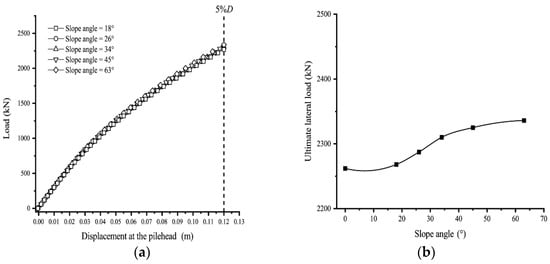
Figure 6.
Slope angle effects on (a) load-displacement curves and (b) pile lateral load capacities.
3.3.2. Effect of Slope Width Sw
Figure 7 depicts the relationship between pile head lateral load and scour width. The influence of scour width on pile lateral reaction is negligible, particularly when the slope width exceeds 0.4 m. However, when the scour width falls between 0 and 0.4 m, the impact is significant. As stated before, this correlates to the major impact of scour on pile lateral capacity when the slope angle exceeds 60 degrees.
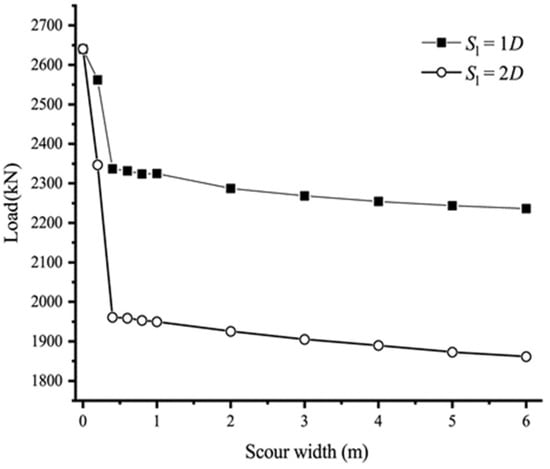
Figure 7.
Pile lateral load capacity with scour width.
3.3.3. Effect of Local Scour Depth Sl
The effect of different scour depths on the lateral capacity of pile foundations was investigated under the condition that the scour angle is 45°. Figure 8 depicts the load-displacement curves of different local scour depths. Both of the six scoured curves are placed below the non-scoured curve. The capacity of the pile is diminished after local scour. Figure 8 depicts the link between capacity and local scour depth. In Figure 8b, similar to Figure 5b, the findings indicate that the capacities fall by 11.93% and 15.90%, respectively, when Sl/D equals 1.0 and 1.5.
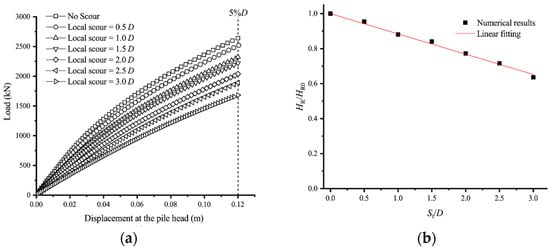
Figure 8.
Local scour effects on (a) load-displacement curves and (b) pile capacities.
The connection between the permissible lateral displacement of 5% of the pile diameter and the local scour depth is likewise essentially linear. Equation (7) illustrates the linear fitting result. The coefficient of determination R² for the linear regression is 99.98%, showing a substantial relationship.
According to Equations (6) and (7), when Sg = 0.8Sl, the capacity loss estimated by both models is nearly identical. The strength of the scour effect is determined by the connection between Sg and Sl. The two Equations (6) and (7) were combined as one Formula (8) for the lateral capacity of pile foundation caused by scour.
3.4. Effect of Scour on Bending Moment
Figure 9 shows the variation in bending moment throughout the length of the pile, taking into account the type and depth of scour. For a lateral load of 765 kN, the maximum bending moment along the pile length rises by between 70% and 87% for Sl/D = 2 and Sg/D = 2, compared to the case of no scour. In addition, when the scour depth grows, the greatest moment of bending occurs at a deeper depth. The maximum bending moment for a pile without scour occurs at a depth of 8.1 m. The maximum bending moment occurs at a depth of 10.2 m and 10.73 m, respectively, for a pile with local and global scour equal to twice the pile diameter. As scour increases bending moments, piles may need to be stiffer or have more reinforcements to make sure that the bending stress does not go above the pile yield stress.
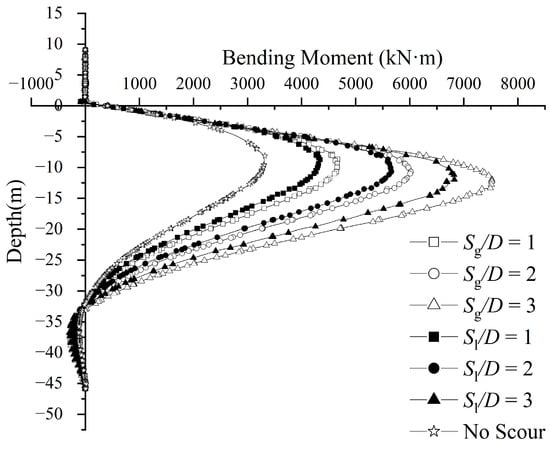
Figure 9.
Bending moment along the pile length for case of different local and global scour depth.
3.5. A SemiEmpirical Formula for Lateral Load Capacity
Equation (8) is used to determine the lateral capacity of the bored pile following scour. According to Chen and Liu [31], the effect of scour on pile ultimate capacity is mostly due to the lowering of initial embedding depth; hence, Equation (8) can be adjusted to Equation (9) by substituting D with L and multiplying the first order coefficient by the L/D ratio. In this study, the L/D ratio is equal to 18.458.
where: is the ultimate capacity after scour, and is the ultimate capacity without scour; Sg and Sl are the depth of global scour and local scour, respectively; L represents the embedding depth of the pile.
The final method for calculating the lateral capacity of a drilled pile after scour is given by Equation (9). This formula is essentially obtained from Equation (8) by a change in parameters and that Equation (8) is actually a linear superposition of Equation (6) (effect of global scour) and Equation (7) (effect of local scour). Equation (9) is expressed by parameters in a framework without dimensions, and it is calibrated for 0D to 3D depths of local and global scour. In the cases of greater scour depth, pile foundations are particularly vulnerable. In those circumstances, reasonable scour protection should be provided, such as using tetrahedral frames [6] and sacrificial piles [33], which may help to reduce the scour depth. At the same time, a reasonable stream evolution analysis should be carried out to calculate the influence of general scour on lateral response. Once the sediment around the pile has been removed in large quantities, riprap protection measures [34] can be taken to increase the support around the pile based on the above equation as a brief assessment. It is worth mentioning that the above equation does not consider the effect of upper fixation, so the formula in this paper is conservative.
3.6. Validation Formula
In Figure 10, the squares, circles, and triangles depict the combination of several scour kinds. As the depth of the scour rises, the impact disparity between the global scour and the local scour becomes more pronounced.
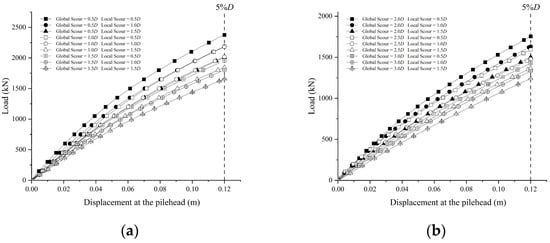
Figure 10.
Combination scour effects on loaddisplacement curves (a) global scour depth had a range from 0.5D–1.5D and (b) from 2.0D–3.0D.
As shown in Figure 11, the triangles are the results calculated by Equation (1), and the stars are the results of Li et al. [35]. In this study, they investigated the influence of scour on the lateral behavior of steel pile LTP-1. The condition of the soil around the steel pile is similar to that in this paper, whereas the L/D ratio of the pile, load eccentricity, and the selection criteria of HR are different as a result of the fact that not all studies adopt 5% of the pile diameter as the maximum deflection of the pile. Nevertheless, the results of the LTP-1 are scattered around the results obtained in this paper. According to the comparison between LTP-4 and LTP-1, the coefficient of the weakening formula is not sensitive to the pile material, diameter, and length.
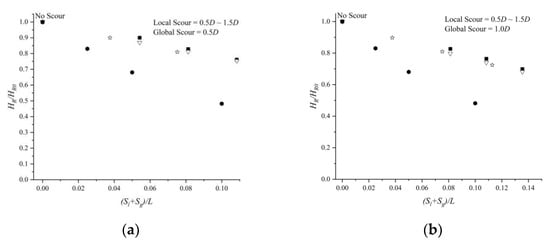
Figure 11.
Validation of the evaluation formula. (a) global scour depth was equal to 0.5D and (b) was equal to 1.0D. In both cases the following legend applies: (▪—Numerical results, ▽—Equation (9), •—Li et al. [35], ☆—Ni et al. [30]).
Yasser (2012) [22] discovered that scour had a greater effect on piles put in sand than on piles installed in clay. This conclusion can also be seen from Figure 11 that scour is more sensitive to non-socketed piles in the sand studied by Ni et al. [30].
The reason that scour will weaken the lateral capacity is that the soil around the pile was taken away, and the weakening of the lateral capacity should be strongly related to the properties of the soil taken away. In view of the above results, it can be concluded that the main factors affecting the scour weakening coefficient are scour types, rock-socketed state, and soil properties. According to Equation (9), the impact of scour on the lateral capacity of rock-socketed piles under marine clay conditions can be quickly assessed without complicated pile-soil interaction analysis. In general, Equation (9) can roughly predict the value of HR/HR0 of rock-socketed piles under clay conditions.
4. Conclusions
For the safety of bridges and coastal constructions, the influence of scour on the reactions of laterally loaded drilled piles in marine clay is an essential topic. In this work, a three-dimensional FE numerical analysis was performed to evaluate this impact. From the numerical results, the following conclusions may be drawn:
(1) Scour types have a significant impact on the pile’s lateral capacity. Under the conditions of global scour and local scour, the lateral capacity of the pile decreases by 14.32% and 11.93%, respectively. Due to the different effects of the two scour types on the lateral response of piles, the semi-empirical scour weakening formulas under the two scour conditions are formed according to the numerical simulation results. Additionally, with increasing scour depth, both types of scour make the maximum point of bending moment look like it is further away.
(2) The main factors affecting the scour weakening effect are soil type and pile condition (rigid or flexible, rock-socking). The weakening effect of piles in sand is stronger, and non-socketed piles are more sensitive to erosion. Among the three parameters (scour width, slope angle, and scour depth) of the local scour hole, scour depth is the main influencing factor of pile lateral capacity. Accordingly, the semi-empirical scour weakening evaluation formula of rock-socked piles is formed and verified.
This article discussed the impact of local scour hole diameters and global scour on drilled piles. It should be noted that vertical impacts were not taken into account due to a lack of field vertical loading data for additional verification, and the piling process was simplified in this research, which means the results are slightly different from the reality, but the overall trend and influencing factors are not affected. In the meantime, the effect of vertical load and pile length on the lateral capacity of a pile has not yet been understood, hence further research is required in this area. In addition, there are insufficient data from field scour for additional confirmation. Although this article’s methodology does not account for the presence of these elements, the detected behavioral tendencies should not be changed. Further research will investigate the interaction between the two parameters of the semi-empirical formula and the mutual effect between the two types of scour in order to increase the precision and application of the formula.
Author Contributions
Conceptualization, C.L. and Y.X.; Data curation, J.L. (Jieqing Liu), Q.L. and J.L. (Jiaming Liu); Funding acquisition, Y.X. and T.Z.; Methodology, C.L.; Project administration, Y.X. and T.Z.; Software, C.L.; Supervision, Y.X. and T.Z.; Validation, C.L. and J.L. (Jieqing Liu); Visualization, Q.L. and J.L. (Jiaming Liu); Writing—original draft, C.L., J.L. (Jieqing Liu) and J.L. (Jiaming Liu); Writing—review and editing, Y.X. and T.Z. All authors have read and agreed to the published version of the manuscript.
Funding
This research was funded by the National Natural Science Foundation of China (Grant number U2240209), the Water Conservancy Science and Technology Project of Jiangsu Province (Grant number 2021055), the Belt and Road Special Foundation of the State Key Laboratory of Hydrology-Water Resources and Hydraulic Engineering (Grant number 521013152), and the 111 Project (Grant number B17015), and the Fundamental Research Funds for the Central Universities (Grant number B210203004).
Institutional Review Board Statement
Not applicable.
Informed Consent Statement
Not applicable.
Data Availability Statement
Not applicable.
Conflicts of Interest
The authors declare no conflict of interest. The funders had no role in the design of the study; in the collection, analyses, or interpretation of data; in the writing of the manuscript; or in the decision to publish the results.
References
- McConnell, J.R.; Cann, M. Assessment of Bridge Strength and Stability under Scour Conditions. In Proceedings of the ASCE SEI 2010 Structures Congress, Orlando, FL, USA, 12–15 May 2010; pp. 121–132. [Google Scholar] [CrossRef]
- Lin, C.; Bennett, C.; Han, J.; Parsons, R.L. Integrated analysis of the performance of pile-supported bridges under scoured conditions. Eng. Struct. 2011, 36, 27–38. [Google Scholar] [CrossRef]
- Lagasse, P. Countermeasures to Protect Bridge Piers from Scour, 1st ed.; Transportation Research Board: Washington, DC, USA, 2007. [Google Scholar]
- Li, Q.; Prendergast, L.J.; Askarinejad, A.; Chortis, G.; Gavin, K. Centrifuge Modeling of the Impact of Local and Global Scour Erosion on the Monotonic Lateral Response of a Monopile in Sand. Geotech. Test. J. 2020, 43, 1084–1100. [Google Scholar] [CrossRef]
- Guan, D.; Chiew, Y.-M.; Melville, B.W.; Zheng, J. Current-induced scour at monopile foundations subjected to lateral vibrations. Coast. Eng. 2019, 144, 15–21. [Google Scholar] [CrossRef]
- Tang, H.-W.; Ding, B.; Chiew, Y.-M.; Fang, S.-L. Protection of bridge piers against scouring with tetrahedral frames. Int. J. Sediment Res. 2009, 24, 385–399. [Google Scholar] [CrossRef]
- Wang, H.; Tang, H.; Liu, Q.; Wang, Y. Local Scouring around Twin Bridge Piers in Open-Channel Flows. J. Hydraul. Eng. 2016, 142, 06016008. [Google Scholar] [CrossRef]
- Melville, B.W.; Raudkivi, A.J. Flow characteristics in local scour at bridge piers. J. Hydraul. Res. 1977, 15, 373–380. [Google Scholar] [CrossRef]
- Xiao, Y.; Jia, H.; Guan, D.; Liang, D.; Yuan, S.; Tang, H. Experimental investigation on scour topography around high-rise structure foundations. Int. J. Sediment Res. 2020, 36, 348–361. [Google Scholar] [CrossRef]
- Melville, B.W.; Chiew, Y.-M. Time Scale for Local Scour at Bridge Piers. J. Hydraul. Eng. 1999, 125, 59–65. [Google Scholar] [CrossRef]
- Liang, D.-F.; Jia, H.; Xiao, Y.; Yuan, S.-Y. Experimental investigation of turbulent flows around high-rise structure foundations and implications on scour. Water Sci. Eng. 2021, 15, 47–56. [Google Scholar] [CrossRef]
- Wang, C.; Yu, X.; Liang, F. A review of bridge scour: Mechanism, estimation, monitoring and countermeasures. Nat. Hazards 2017, 87, 1881–1906. [Google Scholar] [CrossRef]
- Matlock, H. Correlation for Design of Laterally Loaded Piles in Soft Clay. In Proceedings of the 2nd Offshore Technology Conference, Houston, TX, USA, 22–24 April 1970; pp. 577–594. [Google Scholar] [CrossRef]
- Lee, P.; Gilbert, L. Behavior Of Laterally Loaded Pile In Very Soft Clay. In Proceedings of the Offshore Technology Conference, Houston, TX, USA, 30 April 1979; Volume 3401, pp. 387–392. [Google Scholar] [CrossRef]
- Duncan, J.M.; Evans, L.T.; Ooi, P.S.K. Lateral Load Analysis of Single Piles and Drilled Shafts. J. Geotech. Eng. 1994, 120, 1018–1033. [Google Scholar] [CrossRef]
- White, D.J.; Thompson, M.J.; Suleiman, M.T.; Schaefer, V.R. Behavior of Slender Piles Subject to Free-Field Lateral Soil Movement. J. Geotech. Geoenviron. Eng. 2008, 134, 428–436. [Google Scholar] [CrossRef]
- Matlock, H.; Reese, L.C. Generalized Solutions for Laterally Loaded Piles. Trans. Am. Soc. Civ. Eng. 1962, 127, 1220–1248. [Google Scholar] [CrossRef]
- Reese, L.; Wang, S.; Long, J. Scour From Cyclic Lateral Loading of Piles. In Proceedings of the Offshore Technology Conference, Houston, TX, USA, 1 May 1989; Volume 6005, pp. 395–402. [Google Scholar] [CrossRef]
- Fatahi, B.; Tabatabaiefar, S.H.R.; Samali, B. Soil-structure interaction vs Site effect for seismic design of tall buildings on soft soil. Géoméch. Eng. 2014, 6, 293–320. [Google Scholar] [CrossRef]
- Kim, Y.; Jeong, S. Analysis of soil resistance on laterally loaded piles based on 3D soil–pile interaction. Comput. Geotech. 2011, 38, 248–257. [Google Scholar] [CrossRef]
- Lin, C.; Han, J.; Bennett, C.; Parsons, R.L. Analysis of laterally loaded piles in soft clay considering scour-hole dimensions. Ocean Eng. 2016, 111, 461–470. [Google Scholar] [CrossRef]
- Mostafa, Y.E. Effect of Local and Global Scour on Lateral Response of Single Piles in Different Soil Conditions. Engineering 2012, 4, 297–306. [Google Scholar] [CrossRef]
- Kim, Y.; Jeong, S.; Lee, S. Wedge Failure Analysis of Soil Resistance on Laterally Loaded Piles in Clay. J. Geotech. Geoenviron. Eng. 2011, 137, 678–694. [Google Scholar] [CrossRef]
- Kim, Y.; Jeong, S.; Won, J. Effect of Lateral Rigidity of Offshore Piles Using Proposed p-y Curves in Marine Clay. Mar. Georesources Geotechnol. 2009, 27, 53–77. [Google Scholar] [CrossRef]
- Hamill, L. Bridge Hydraulics; CRC Press: Boca Raton, FL, USA, 2014; ISBN 148227163X. [Google Scholar]
- Guan, D.; Chiew, Y.-M.; Wei, M.; Hsieh, S.-C. Characterization of horseshoe vortex in a developing scour hole at a cylindrical bridge pier. Int. J. Sediment Res. 2018, 34, 118–124. [Google Scholar] [CrossRef]
- Cheng, N.-S.; Wei, M. Scaling of Scour Depth at Bridge Pier Based on Characteristic Dimension of Large-Scale Vortex. Water 2019, 11, 2458. [Google Scholar] [CrossRef]
- Broms, B.B. Lateral Resistance of Piles in Cohesive Soils. J. Soil Mech. Found. Div. 1964, 90, 27–63. [Google Scholar] [CrossRef]
- Jawad, S.; Han, J. Numerical Analysis of Laterally Loaded Single Free-Headed Piles within Mechanically Stabilized Earth Walls. Int. J. Géoméch. 2021, 21, 04021038. [Google Scholar] [CrossRef]
- Ni, S.-H.; Huang, Y.-H.; Lo, K.-F. Numerical Investigation of the Scouring Effect on the Lateral Response of Piles in Sand. J. Perform. Constr. Facil. 2012, 26, 320–325. [Google Scholar] [CrossRef]
- Chen, X.; Liu, J. Three-dimensional scour hole model and scour effects on the ultimate capacity of lateral loaded rigid piles. Appl. Ocean Res. 2022, 121, 103115. [Google Scholar] [CrossRef]
- Richardson, E.V.; Davis, S.R. Evaluating Scour at Bridges; Hydraulic Engineering Circular (HEC) No. 18; U.S. Department of Transportation: Washington, DC, USA, 2001. [Google Scholar]
- Melville, B.W.; Hadfield, A.C. Use of Sacrificial Piles as Pier Scour Countermeasures. J. Hydraul. Eng. 1999, 125, 1221–1224. [Google Scholar] [CrossRef]
- Esteban, M.; López-Gutiérrez, J.-S.; Negro, V.; Sanz, L. Riprap Scour Protection for Monopiles in Offshore Wind Farms. J. Mar. Sci. Eng. 2019, 7, 440. [Google Scholar] [CrossRef]
- Li, F.; Han, J.; Lin, C. Effect of Scour on the Behavior of Laterally Loaded Single Piles in Marine Clay. Mar. Georesour. Geotechnol. 2013, 31, 271–289. [Google Scholar] [CrossRef]
Publisher’s Note: MDPI stays neutral with regard to jurisdictional claims in published maps and institutional affiliations. |
© 2022 by the authors. Licensee MDPI, Basel, Switzerland. This article is an open access article distributed under the terms and conditions of the Creative Commons Attribution (CC BY) license (https://creativecommons.org/licenses/by/4.0/).